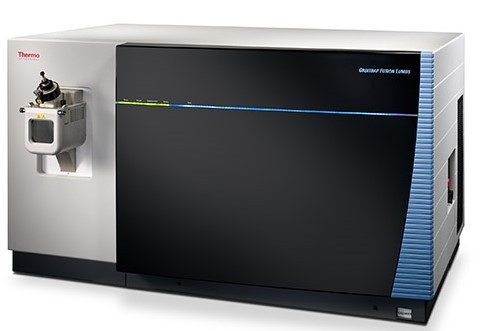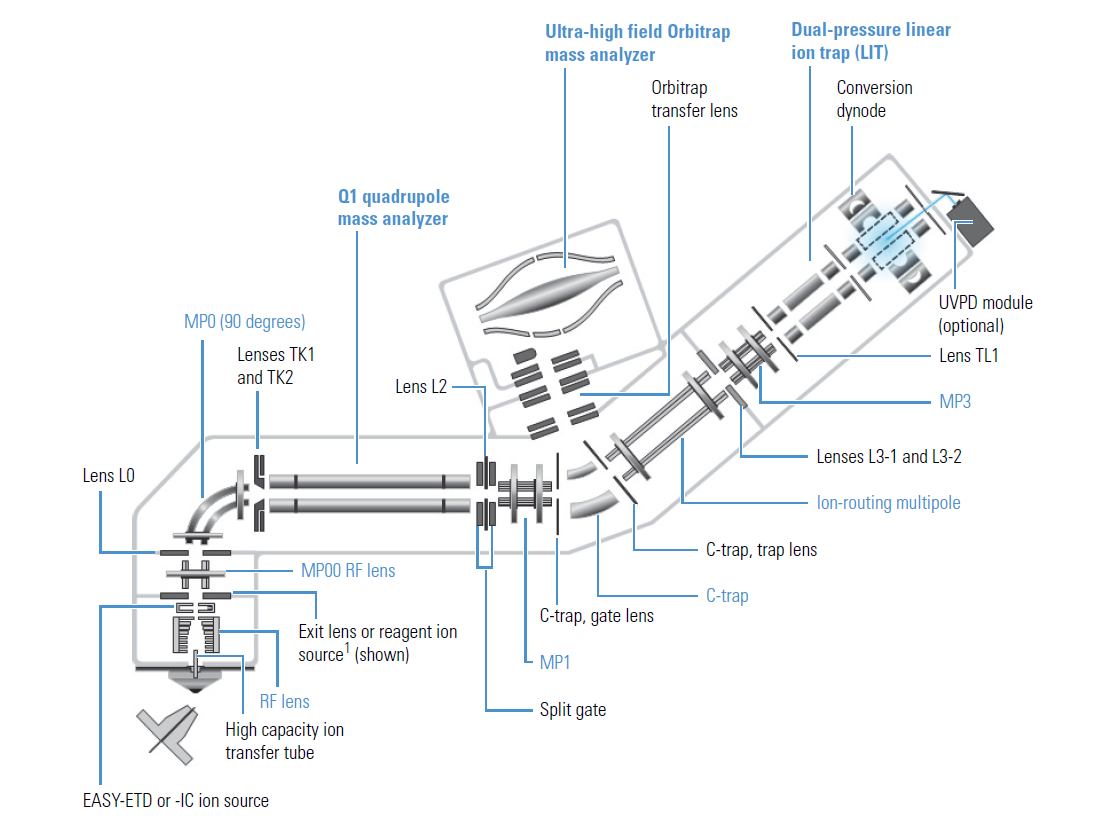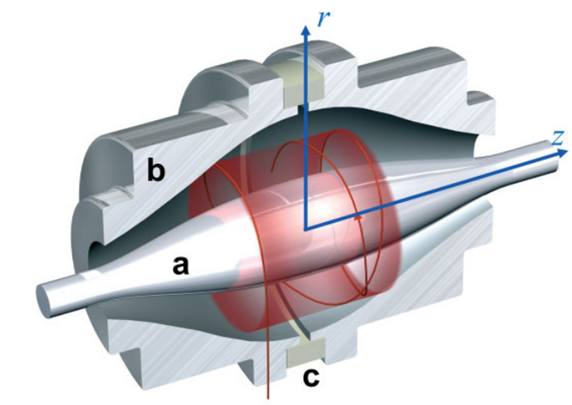The Thermo Scientific has introduced the Orbitrap Fusion Lumos Tribrid Mass Spectrometer (Figure 1) that can be used for advanced proteomics, metabolomics, and biopharma. This mass spectrometer is the industry-leading high-performance mass spectrometer with enhanced sensitivity. It contains three mass analyzers, quadrupole, Orbitrap, and linear ion trap (LIT).

Figure 1. Orbitrap Fusion Lumos Mass Spectrometer
The Structure of Orbitrap Fusion Lumos Mass Spectrometer

Figure 2. Schematic for Orbitrap Fusion Lumos Tribrid Mass Spectrometer
After separated by liquid chromatograph (LC) column, compounds pass through a sample transfer line and enter the mass spectrometer (MS) for ionization and analysis. The MS can provide information about the mass-to-charge ratios (m/z) of compounds, as well as structural and quantitative information by performing MSn experiments. The basic structure of Orbitrap Fusion Lumos tribrid mass spectrometer includes ion source, ion optics, mass analyzer, and detector. Next, the characteristics and roles of each part will be introduced.
Ion Source
The ion source connected to LC is atmospheric pressure ionization (API). The API source serves as the interface between the LC and the MS and includes the following ionization techniques: heated-electrospray ionization (H-ESI), atmospheric pressure chemical ionization (APCI), and atmospheric pressure photoionization ionization (APPI). In addition to API source, there is a second ion source (RIS), located in the API source interface just after the electrodynamic ion funnel.
Ion Optics
The ion optics focus and accelerate the gas-phase sample ions into the mass analyzer. It includes MP00 ion optics, MP0 ion optics, MP1 ion optics, curved linear trap (C-trap), ion-routing multipole (IRM), MP3 Ion optics, and DC offset voltages. The MP00 ion optics, including the MP00 RF lens and the L0 lens, are located between the API source interface and the MP0 ion optics. The MP0 ion optics, also called the active beam guide (ABG), transmit ions from the MP00 ion optics through a 90-degree arc along the central axis to quadrupole. The 90-degree arc can reduce noise via preventing neutral species and high-velocity clusters from entering quadrupole. The MP1 ion optics, acting as an ion transmission device, transmit ions from quadrupole to the C-trap by the way that MS applies a radio frequency (RF) voltage to the rods to generate an electric field that guides the ions along the axis of the multipole. After entering the C-trap, ions lose their kinetic energy by colliding with the nitrogen collision gas and are bunched to the center axis of the C-trap. The IRM contains a straight multipole mounted inside a metal tube with a direct line-of-sight to the C-trap. A potential gradient is applied to the multipole to provide fast extraction of the ions. The MP3 ion optics can transmit ions from the IRM to the dual-pressure LIT through the way that RF voltage is applied to the rods to generate an electric field that guides the ions along the axis of the multipole.
Mass Analyzers
The Orbitrap Fusion Lumos MS contains three mass analyzers, including quadrupole, Orbitrap, and LIT.
Quadrupole mass analyzer (Q1) contains four circular rods. The MS applies an RF voltage and a DC offset voltage to the rods. When the variable amplitude of RF and DC voltages are applied to the quadrupole rods which can generate an electric field, the electric field can give stable oscillations to ions with a specific m/z and unstable oscillations to all others. Namely, the Q1 act as a mass filter to enable selected ions to pass through the rods. When it only applies to the RF voltage, the quadrupole acts as ion transmission devices.
The axially-symmetrical Orbitrap mass analyzer contains a spindle-shaped central electrode surrounded by a pair of bell-shaped outer electrodes. The moving ions can be trapped in an electrostatic field. The electrostatic field which ions experience inside the Orbitrap forces them to move in complex spiral patterns. The axial component of these oscillations can be detected as an image current by the two halves of the electrode. A Fourier transform is employed to convert the image current to a mass spectrum.
LIT mass analyzer is a dual-cell and two-dimensional LIT mass analyzer that consists of a front transfer lens (TL1), a high pressure LIT cell, a center transfer lens (TL2), a low pressure LIT cell, and a back transfer lens (TL3). Inside the mass analyzer cells are square arrays of precision-machined and precision-aligned hyperbolic rods that have three sections (front, center, and back section).
The LIT mass analyzer has several steps, including ion storage, ion isolation, collision induced dissociation (CID), and ion scan-out. For SIM or MSn, the LIT mass analyzer applies the ion isolation waveform voltage to the X-rods with a ramp of the main AC voltage to a new storage voltage, ejecting all ions except those of the selected m/z. In addition, for the MSn, the LIT mass analyzer applies the resonance excitation AC voltage to the X-rods to cause CID. To scan out the ions, the main RF voltage ramps up from low voltage to high voltage, and simultaneously the MS applies the resonance ejection AC voltage to the X-rods to facilitate ejection. As the main RF voltage increases, ions of increasing m/z values become unstable and eject through the slots in the X-rods.

Figure 3. Schematic of the Orbitrap cell

Figure 4. A) Linear ion trap in the Orbitrap Fusion Lumos MS. B) Assembly for the linear ion trap
Ion Detection Systems
The Orbitrap Fusion Lumos MS has a high-sensitivity and off-axis ion detection system. The detection system contains two conversion dynodes and one electron multiplier. It produces a high signal-to-noise ratio (S/N), which is proportional to the number of ions detected, and enables voltage polarity switching between positive and negative ion modes of operation.
Scan Type of Orbitrap Fusion Lumos MS
MS scan
The MS scan (or full-scan MS) corresponds to a single stage of mass analysis. In this scan type, the ions formed in ion source are stored in the IRM. The ions are then transferred to the Orbitrap or LIT mass analyzer to produce a full mass spectrum of the observable ions in the specified mass range. The MS scan can be used for qualitative and quantitative analysis. This scan type is useful to determine the molecular weight and intensity of compounds.
MS2 scan and MSn scan
The MS2 scan selects the MS/MS mass analysis. In the first stage of MS/MS scan, you can choose the Quadrupole or the ion trap to select ions. The selected ions are then transferred to higher-energy collisional dissociation (HCD) in the IRM, or to the LIT for CID, electron transfer dissociation (ETD), or UVPD. In the second stage of MS/MS scan, the product ions are transferred into the orbitrap or the LIT for analysis and detection. In the MSn scan, the scan power of n is typically from 2 to 10, which means it involves 2-10 mass analysis stages. Each stage contains an ion selection step. When the scan power is higher, the more structural information of compounds can be obtained.
SIM scan
The selected ion monitoring (SIM) is a single stage of mass analysis, which can monitor a particular ion or a set of ions. In this scan type, the ions in the defined m/z range are selected and detected by orbitrap or the LIT to produce a mass spectrum of SIM.
The Latest Technologies in Orbitrap Fusion Lumos MS
EASY-IC option. The Orbitrap Fusion Lumos MS has a second ion source (RIS), located in the API source interface just after the electrodynamic ion funnel. This Internal Calibration can improve the m/z assignment accuracy to less than 1 ppm. The RIS generates internal calibrant ions for real-time mass calibration of MS scans in both positive and negative modes.
EASY-ETD option. ETD is a dissociation method of fragmenting multiply-charged gaseous molecules by transferring electrons to them. ETD and EThcD HD modes are techniques on Orbitrap Fusion Lumos MS to increase detection limits and dynamic range of ETD spectra.
Ultraviolet Photodissociation (UVPD) options. The Orbitrap Fusion Lumos MS with UVPD provides an additional and unique MSn capability. This novel fragmentation mode with the versatility of the tribrid platform permits for an in-depth structural analysis of large and small molecules for Proteomics and Metabolomics.
1,000,000 FWHM ultra-high resolution. The ultra-high resolution with MSn capability and various fragmentation modes permits the comprehensive characterization of a wide range of analytes.
Applications of Orbitrap Fusion Lumos MS
The Orbitrap Fusion Lumos Tribrid MS with superior sensitivity, selectivity, and versatility to enable researchers to obtain the highest quality data. Equipped with the brightest ion source, the most selective quadrupole, the fastest ion trap analyzer, enhanced dissociation technologies and an ultra-high resolution Orbitrap analyzer, it can be used for many challenging applications.
Post-translational Modification (PTM) Analysis
PTMs regulate activity localization, and interaction with other cellular molecules such as proteins, nucleic acids, lipids, and cofactors. Hence, they play an important role in the functional proteomics. The Orbitrap Fusion Lumos MS, with several fragmentations like CID, HCD, ETD, and EThcD are helpful for PTM analysis, especially glycosylation. For example, ETD and EThcD can provide MS/MS spectra of glycopeptide backbone fragmentation, which leads to accurate modification site localization.
Mass spectrometry plays an important role in protein quantitation. Multiplexed analyses using isobaric mass tags are widely used for high throughput quantitative comparisons of protein abundances. The Orbitrap Fusion Lumos MS can perform the isobaric labels tandem mass tagging (TMT), which enables the simultaneous analysis of 10 samples with improved quantitative accuracy. This advanced instrument offers selectivity and enhanced sensitivity to obtain the maximal performance, meanwhile, high reproducibility of quantitation for low abundance analytes can be maintained.
Intact Protein Analysis
Top-down proteomics, usually analyzing intact proteins, offers information about PTMs, protein isoforms, and protein sequence through fragmentation of the intact proteins in the mass spectrometer. Orbitrap Fusion Lumos MS, equipped with advanced vacuum technology, provides optimized conditions for improved performance with intact protein analysis. Combined with diversity fragmentation, ETD HD of Orbitrap Fusion Lumos MS can provide the improved detection limits and dynamic range, resulting in the greater sequence coverage at faster acquisition rates. In addition, it can be used for high accuracy mass analysis of the intact monoclonal antibody with isotopic resolution of the heavy and light chains.
Small Molecule Analysis
Due to the high sensitivity and high resolution, the Orbitrap Fusion Lumos MS is a useful instrument for identification and quantitation of small molecules. It can be used for the determination of highly accurate molecular formulae because the fine isotopic structure can be observed. This direct measurement removes the ambiguity of pattern matching estimations. In addition, the brighter ion source makes it to achieve far lower levels of quantitation.
The Thermo Scientific Orbitrap Fusion Lumos Tribrid mass spectrometer has some advanced features, including a new API interface, advanced Quadrupole technology, high-field Orbitrap analyzer, and a dual-pressure linear ion trap. The unique instrument architecture can perform multiple dissociation techniques (like HCD and CID) at any fragmentation stage and analyze ions in either the linear ion trap or Orbitrap mass analyzer. At Creative Proteomics, we can provide various services based on our Orbitrap Fusion Lumo Tribrid mass spectrometer platforms, including:




